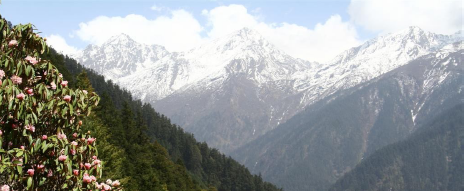Ecosystems, Development and Climate Adaptation: Improving the base for policies, planning and management


Nepal
Nepal is characterised by a range of climatic and ecological zones – from low-lying tropical areas (Tarai region), through temperate hills and mountains, to the alpine Himalayas – supporting a rich and unique biodiversity. The lowland Tarai region is considered the ‘rice bowl’ or ‘agricultural production-house’ of Nepal, as well as being home to a number of key species including tigers, Asian rhinos and elephant. While Nepal is endowed with cultural, agricultural and biological diversity, many residents experience chronic poverty. It is estimated that about 31% of people earn less than $2 a day. Poverty is especially severe in rural areas where people depend heavily on forests and land resources for livelihoods. Agriculture and foreign remittances continue to drive the country’s GDP. However, with improved peace and security in recent years, tourism has once again become an important source of national income. After the end to a decade of conflict, the new government has set out its priorities for large-scale developmental projects, notably hydropower and road building.
Nepal faces a number of climate-related risks including rising temperatures causing increased snow melt, more extreme and frequent flash floods, glacial lake overflows and landslides with devastating impacts for settlements and farmlands on the lower slopes. In addition, there is a rising concern over long-term water scarcity as snow cover retreats and flows of melt water decline, with significant implications for agriculture and hydropower generation.
In light of this, WWF and SEI teamed up to investigate the role of ecosystems in meeting the inter-linked challenges of climate change adaptation and development in Nepal, and what changes might be needed in the governance system to address issues of environmental degradation, poverty alleviation and climate change in a more integrated way. Various qualitative methods and tools were employed to address these questions and facilitate shared learning with key stakeholders in the Nepalese government and civil society.
Findings from the study suggest that while significant progress has been made in recent years formulating policies and plans that explicitly address climate change issues, for example the National Strategy for Disaster Management (2008), the Climate Change Policy (2009) and the extended National Adaptation Plan of Action (NAPA+), there are critical challenges around implementation and donor harmonization.
Most policy and planning documents do not explicitly include the terminology “ecosystem-based” but do have strong elements of sustainable management of natural resources as a basis for improving people’s livelihoods and wellbeing. They look good on paper, despite some overlaps and contradictions that still need to be resolved, but with limited progress on implementation many study participants found it difficult to judge the practicality and effectiveness of these new policies and plans at this stage.
There has been a sudden influx of climate change donor funding into Nepal, stimulating lots of activities at the national and local levels. However, to date there has been hardly any record or knowledge of who is doing what, how much finance has been put into what projects and programmes, which approaches are being taken and which policy frameworks have informed the design – highlighting the need for institutional innovations to enable better coordination.
This work was collaboratively undertaken by SEI Asia, WWF Nepal, SEI Oxford and WWF UK. As part of this study similar work also took place in Belize and Tanzania. For the key lessons drawn from comparing the 3 country studies read this article: Key lessons about strengthening governance to adapt to climate change
(0) Comments
There is no content